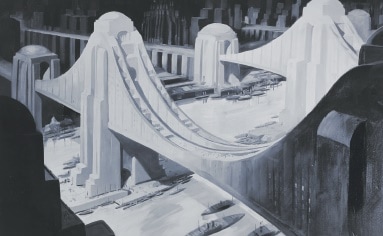Skyscraper Bridges?
By Sam Lubell and Greg Goldin
One of the most glorified skyscraper creators in Roaring Twenties America was Raymond Hood, who designed 30 Rockefeller Plaza, the McGraw-Hill Building, the Daily News Building, and the American Radiator Building in Manhattan, as well as the Tribune Tower in Chicago, and numerous other structures.
Hood was obsessed with tackling congestion, which, by the 1920s and 1930s, had become an epidemic of unprecedented scope. In addition to outlining a City of Towers–spaced carefully above grassy open plazas and wide streets, increasing density without unduly increasing traffic–Hood looked to the waterfront, where his “apartment bridges” would similarly reduce crowding while providing a unique, water-focused lifestyle.
This is the fourth in a series of posts drawn from the authors'recent work
Never Built New York, published courtesy of Metropolis Books.
A February 1925 article in the New York Times outlined Hood’s plan for 50- to 60-story towers of apartments on either side of a broad roadway, housing an estimated 50,000 people over a suspension bridge spanning 10,000 feet. Shops, theaters, and esplanades would provide lovely diversions on the bridges, while elevators could bring residents down to the water for boating, swimming, and more aquatic fun.
In writer Orrick Johns’s eyes, the structures––which were supported via the bridge’s own cables–were unparalleled in human achievement, despite copious earlier efforts to put residences on bridges. “Quaint and memorable as London Bridge must have appeared,” wrote Johns, “and as the Ponte Vecchio is, these bridges would seem toys beside the inhabited structures contemplated for New York.”
In his book The Metropolis of Tomorrow, Hood’s collaborator on the project, illustrator Hugh Ferriss, praised the buildings’ desirable exposure to light and air, and tried to assuage fears about the plans. “Serious minds have claimed that the project is not only structurally sound but possessed of unusual advantages, financially,” he wrote. An image that Hood produced of his “easily practicable plan” showed more than a dozen such bridges spanning both the Hudson and East rivers.
Said Hood: “Not to embrace this opportunity is to neglect the very pick of metropolitan locations.”
Said Johns: “Land has often been reclaimed from water for purposes of habitation and agriculture. What is so extraordinary about creating land over water?”
Sam Lubell is a Staff Writer at Wired and a Contributing Editor at the Architect’s Newspaper. He has written seven books about architecture, published widely, and curated Never Built Los Angeles and Shelter: Rethinking How We Live in Los Angeles at the A+D Architecture and Design Museum. Greg Goldin was the architecture critic at Los Angeles Magazine from 1999 to 2011, and co-curator, and co-author, of Never Built Los Angeles. His writing has appeared in The Los Angeles Times, Architectural Record, The Architect’s Newspaper, and Zocalo, among many others.


